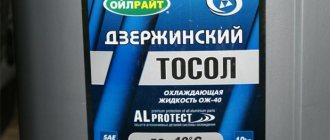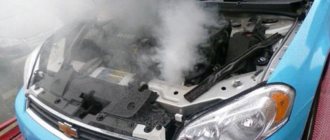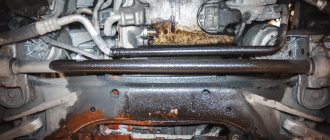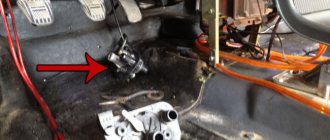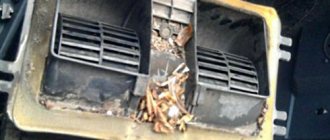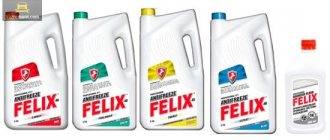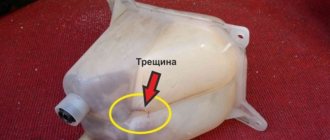Coolant (antifreeze or antifreeze) is an integral consumable item for every car.
Refrigerants of red, blue, green and other colors differ in composition and set of additives. However, not all antifreezes retain their original color throughout their entire service life.
A common situation is when, just a few days after filling, the coolant darkens, boils and foams, which causes serious trouble for the driver.
In this article we will answer the question “Why did the antifreeze turn rusty?” Let's look at what causes this problem and how to avoid it.
Consequences of failure to replace
As it is used, the coolant loses its properties and ceases to be effective. Its further circulation within the system brings more problems than benefits.
Due to old and worn-out coolant, the cooling system is subjected to very serious loads, and the engine overheats. This leads to all sorts of malfunctions, some of which may well result in a major overhaul.
If you do not change the coolant, you will simply destroy your own engine with your own hands.
Causes of darkening
There are not many of them, but they all reflect important problems. Moreover, sometimes the antifreeze is brown, sometimes black (sometimes with flakes), but sometimes it also foams.
- The deadline has passed . As I already wrote above, it gets dark because the additives (base) simply stop working. Plaque and sediment may form inside
- Oxidation of the walls inside . Based on the first point, it can be understood that the protection of metal parts no longer occurs as needed; the walls begin to oxidize. Rust appears and that's why it turns brown
- Rubber parts . Again, we look at point “1”, antifreezes (antifreezes) are active substances, if they do not contain additives (which restrain their ardor), then they can destroy the walls of hoses, pipes and other things. Moreover, in this process a blackish tint is formed
- Boiling. Because the additives have stopped working, boiling inside the system is possible; of course, all this can go into the expansion tank. The whole point is that normally working antifreeze can withstand temperatures of 120 degrees, and already worn-out antifreeze will begin to form bubbles at 90. This negatively affects the fluid as a whole (including its color) and the condition of the engine.
- Tap water. On a long journey, it happens that the system leaks, for example, a hose bursts. You eliminate it, but the “cooler” you need is not nearby (to complete the level)! You pour regular tap water or from a mineral water bottle. But this water is not intended for the system; it will leave scale on the walls. Again, the formation of a brown tint is possible.
- Engine oil. Sometimes oil gets into the cooling system, either through the heat exchangers or through the head gasket. It gives a dark color
- Additives. Adding all sorts of miracle products to the radiator (for example, to eliminate a leak). No matter what anyone says, they also don’t understand how they react to antifreeze or “TOSOL”; the color will most likely change after their use.
- White deposits (emulsion flakes) on the lid or walls of the expansion tank. Well, and lastly, a white coating sometimes forms (although the liquid itself is of a normal shade), sometimes in the form of flakes, sometimes just in the form of a film. This is engine oil getting into the system, either during repairs, or the head gasket is broken. You can’t delay repairs, you need to fix them
In any case, if the color has changed, then you need to take urgent action - REMEMBER THIS IS NOT NORMAL.
Is it possible not to change the coolant and continue driving?
All types of coolant have a certain service life. After some time, the antifreeze will lose its characteristics. What does this lead to? That's right, to engine overheating! What does overheating lead to? In the best case, engine power will seriously drop and oil consumption will increase. At worst, it will simply jam and you will not be able to continue moving.
If antifreeze (antifreeze) darkens, it is better to solve the problem immediately, since in the future this may lead to more serious difficulties that require significant financial investments. Change the fluid in your car's engine cooling system in a timely manner and remember that prevention is always cheaper than repairs!
When to be wary
- The coolant darkened greatly and acquired a shade that it could not achieve naturally.
- You can see rust in the liquid, the color itself looks rusty.
- The change in shade is combined with inclusions of oil or other liquid in the antifreeze, which should not be in the cooling system during normal operation.
If a change in color leads to the development of an unpleasant odor, the appearance of smoke or other alarming signs, it is necessary to urgently carry out repairs: this may indicate serious deviations in the operation of the systems.
Why did antifreeze turn brown?
Antifreeze color
Antifreeze is a special coolant used in a car. The main function of this fluid is to regulate the temperature of the engine during operation. Antifreeze is usually made in blue color. But it happens that certain varieties of this coolant are produced in a different color. For example, the Tosol - 65 brand is red.
Brown antifreeze that was drained from the car
If the color of the antifreeze has changed, it usually means one thing: the coolant has lost its properties. First, the antifreeze becomes greenish, then yellow and finally colorless.
Thus, the loss of color for antifreeze is characterized, first of all, by the fact that the liquid gradually becomes unusable. The unsuitability lies in the development of corrosion inhibitors that interfere with the normal operation of the car.
The speed at which antifreeze changes its color indicates the following:
- If the antifreeze turns yellow after about five hundred hours of operation, then there is a fact of incorrect engine operation, that is, the engine is overheating - above 105 degrees
- If the antifreeze turns green during the same five hundred hours of operation, then the engine runs without overheating
But antifreeze can turn black, brown, and red. There are several explanations for the change in color of the coolant during vehicle operation:
- Antifreeze has lost its properties
- There may be a breakdown of the radiator with the stove or the formation of a corrosion process of the radiator
- A corrosion process has occurred in the engine system
Here are the main reasons why antifreeze turned black or brown.
If the antifreeze turns brown, urgent replacement is necessary.
If a change in the color of the coolant is detected, first of all it is necessary to check the operation of the car engine.
If no obvious overheating is observed during operation, then the antifreeze is still suitable for use and works correctly. The color has changed, possibly due to burnt-out additives or due to rust in the pipes.
In such a situation, replacing the coolant will not be superfluous, but, on the other hand, it is not required.
In the case when the antifreeze has turned brown or black, and there is obvious overheating of the engine, then in such a situation it is necessary to replace the used fluid with a new one as quickly as possible.
Why did antifreeze turn red?
The antifreeze in the reservoir has turned brown
Sometimes antifreeze becomes reddish over time. The reason for this may be the intensive operation of the engine, which leads to prolonged high temperature loads.
For example, if the car very often gets into traffic jams or moves for a long time at maximum speed. That is, the antifreeze cannot cope with the load and begins to acquire a red color.
This color, by the way, is obtained as a result of the dissolution of iron particles from cylinder blocks.
The reason for this process may be a low-quality or outdated antifreeze formulation, which simply cannot cope with the loads on the car engine.
The fact is that the modern design of cooling systems in cars (even in modern VAZs) is made in such a way that excessive pressure often occurs in the antifreeze, and the boiling point rises to one hundred twenty or one hundred thirty degrees.
And at such high temperatures, corrosion inhibitors cease to provide the necessary protection. From this we can conclude that antifreeze, which was produced in the Soviet Union, is not always suitable for modern vehicles.
Reasons for color change
When analyzing this topic, there are several main factors that lead to antifreeze changing its color to red, white or dirty brown.
The liquid has expired.
This was just mentioned at the very beginning of the article. Over time, the additives that make up antifreeze lose their properties and cannot perform their intended functions. Because of this, a characteristic deposit appears in the cooling system. It changes the colors of antifreeze.
Engine overheating and coolant boiling.
If the antifreeze was not replaced in a timely manner and the system overheated, then the liquid itself boils. This also leads to the final loss of coolant properties and a change in its color.
Oxidation of metal parts of the cooling system.
This may be due to the end of the antifreeze’s service life and loss of its properties (the components do not provide protection against corrosion), or to the purchase of low-quality liquid. The internal walls of the system are made of metal; they oxidize and change the color of the liquid to rusty.
Destruction of rubber pipes.
In some cases, if antifreeze is not replaced in a timely manner, the rubber components of the system begin to deteriorate. When such particles enter a liquid, its color changes, but not to brown, but rather to black.
Using water as a coolant.
There are situations when the antifreeze level has dropped, and there is no way to top it up. Then they resort to adding distilled or filtered water. But you need to understand that this measure is temporary and emergency. After this, you need to flush the system and fill in new antifreeze. If you overuse adding water, you can render both the liquid itself and the entire system unusable.
Contact with engine oil.
If the cylinder block or heat exchanger gasket is damaged, coolant will come into contact with the engine oil. As a rule, then the antifreeze not only darkens, but becomes like a kind of beige emulsion. Experienced owners nicknamed it condensed milk. In appearance it is really very similar.
Contact with radiator leak repair products.
To eliminate radiator leaks, many motorists use a variety of sealants. They actually fix the problem in the short term. But after contact with them, antifreeze may change color to brown.
Any of the situations described should not be ignored. Each of them requires certain actions by the car owner if he does not want to then spend time and money on car repairs.
Replaced it after a couple of weeks, dark again
This also happens, it seems like I drained the old fluid and poured in a new clean one, but a couple of weeks passed and it’s dark again. WHY? YES it's simple. You didn't flush the system, THIS IS A GREAT MISTAKE!
When the antifreeze is new, it begins to wash away all the old plaque from the walls and pipes inside. It is because of this that even new liquid will quickly turn back into brown.
Therefore, we remember - be sure to rinse.
Now we are watching the video version.
I’ll end here, I think my article and video were useful to you. Sincerely yours, AUTOBLOGGER.
Similar news
- How to choose anti-freeze for a car? Cheap and odorless
- DIY WD-40. How to make an almost complete analogue
- Antifreeze (antifreeze) into the washer reservoir. Filled, what should I do?
Add a comment Cancel reply
What will happen if you don't change?
So, we have already understood that replacing antifreeze must be carried out in accordance with the regulations provided by the manufacturer. This will avoid many problems with the operation of the cooling system. But let's see what happens if you decide not to change the fluid. There may be several consequences here.
Accumulated water will cause corrosion in the engine cooling jacket passages. At the same time, not only will the cooling of the power unit deteriorate, but also complete failure of the motor is possible.
Also, over time, antifreeze becomes less resistant to freezing. This difficulty is relevant for residents of regions with harsh winters. As a result, you may end up with a defrosted system, which in this case will lead to a complete replacement of the engine.
Old antifreeze or antifreeze cools the engine much worse. Therefore, there is a risk of engine overheating. In this case, you will also have to change the power unit.
What antifreezes are ethylene glycol used in?
Now there are generally accepted standards, these are antifreezes G11 (G11+), G12 (G12+, G12++), and in our antifreezes (in fact, they belong to the G11 family). If you sort it by color, it is blue, green, red.
Now in more detail:
Safety. Ethylene glycol is a toxic liquid that can poison a person not only when ingested, but also through the pores of the skin and when inhaled! Therefore, they are now trying to reduce its use. It is worth noting that if a person remains in a room where this liquid has been spilled for a couple of hours, it can cause severe poisoning. And if it gets inside, it will lead to death in 60 - 70% of cases.
Temperature threshold. Do you know that pure ethylene glycol freezes at -12 degrees. However, if you break it up with water, you can reach temperatures of -40 to -50 degrees. Find out how to properly dilute such concentrates here.
Corrosion resistance. It should be noted that it corrodes almost all types of materials, metals (cast iron, aluminum, brass, copper, etc.), rubber. Therefore, the concentration of additives must always be sufficient.
Flammable Fires of antifreeze based on it are often possible, especially when water evaporates. So if there is only 15% water left, then it can simply catch fire. If the water level is 40%, then popping sounds are possible. So the water level should always be normal.
Now it is practically prohibited, in many European countries, here in Russia, as well as in neighboring countries - ALLOWED. Therefore, you need to handle antifreezes based on it very carefully; storing it at home is not recommended! Open storage is not recommended! Poisoning and even fire are possible. The time of ethylene glycol is passing, it is outdated and does not meet all the characteristics currently required.
Solution
It all depends on what exactly led to the change in coolant color. If you see an emulsion or drops of engine oil in the expansion tank, we advise you to address the problem as soon as possible. You need to dig towards the cylinder head gasket or heat exchanger. Only in these places can contact between engine oil and antifreeze usually occur. You should not delay it, since such a mixture will clog the system, and the engine will not cool properly. In such a situation, after eliminating the cause of the emulsion, the cooling system is thoroughly flushed and the antifreeze is replaced.
If the reason for the appearance of a brown (rusty) color of antifreeze is the end of its service life, it only needs to be replaced.
Important! In any case, flush the engine cooling system. Use only distilled water for this. Rinse until the water is clear. Only then fill in new coolant.
If you replaced the antifreeze, some time has passed (days or weeks) and its color has changed again, this means that the cooling system flush was not done in good faith.
You may also be interested
Antifreeze goes into the engine: signs and causes
If antifreeze leaks into the engine, then this is a serious problem that requires a solution as quickly as possible. Therefore, every motorist should be able to recognize its signs, know precautions and remedies.
Why antifreeze curdled: reasons and what to do
In some cases, a motorist may find foamed and heterogeneous rust-colored something under the cover. In this case, experienced drivers state: “The antifreeze has curdled.” Why does this happen and how to deal with it? This is exactly what we will discuss with experts in an article on our website.
Why does the coolant in the engine darken?
If the coolant has not yet reached its full mileage, but has already darkened, this does not indicate anything good. Not only will you need to change the antifreeze itself, you also need to find out the reason that led to this problem. The following are the main reasons why the coolant in a car engine darkens:
As you can see from the reasons described above, most often the darkening of antifreeze is associated with its quality. If the fluid has expired or is of poor quality, it will most likely darken. You can consider the darkening of antifreeze as a signal that it needs to be changed, but remember that often such a problem can arise due to a number of reasons, and not just because of the quality of the liquid itself.
Every motorist should periodically check the fluid level in the expansion tank of the engine cooling system. This is the same procedure as, which also needs to be performed regularly. And now, the next check shows that the antifreeze (or antifreeze) has changed its usual color to rusty or brown. We all know that coolant should be red, blue or green. What could be the reason for the change in the original color of antifreeze (antifreeze)? Is it possible to continue using such a car or does the problem need to be solved?
At the beginning of this article, it is worth mentioning that the liquid in a car’s cooling system has a certain service life, which is specified by its manufacturer. As a rule, this figure is approximately 50 thousand kilometers. It all depends on the cost of the product and its characteristics. During the production of antifreeze, different substances are used, therefore the service life of liquids from different companies can vary significantly.
There are several nuances that will help increase the resource of “Antifreeze” or antifreeze:
- The first thing to remember is that the consumables should always be of the highest quality. If you do not want to face the problem of darkened Antifreeze, then you cannot use liquid purchased from merchants on the side of the road or in unverified stores. If you are using original products, pay attention to checking the place of production. Sometimes high-quality European antifreezes are made in China or Mongolia, which, of course, indicates their poor quality.
- The performance characteristics of the fluid should also be given attention. You should know which specific antifreeze your car manufacturer recommends using. There are certain additives, the use of which is permitted or not permitted by the machine manufacturer. Therefore, such nuances should be taken into account.
- The cooling system should always be flushed before replacing consumables. Regardless of whether obvious deposits are visible in the expansion tank or not. Flushing will always help get rid of sediments that may not be visible to the naked eye. In any case, even after a year of operation of the coolant, there will be deposits in the system pipes, let alone three to four years of using the refrigerant.
Why did the antifreeze quickly darken after replacement?
You need to figure out whether there are contaminants in the cooling system. Since the refrigerant can quickly darken due to the fact that the cooling system has not been flushed. Impurities and deposits remain inside the channels and hoses, which end up in the recently filled antifreeze, which circulates in a circle.
Therefore, during a scheduled fluid change, it is necessary to drain the old Antifreeze and add water or the compositions described above to the radiator. Having cleaned the system in this way and gotten rid of the dirty substance, you can safely refill the car with new antifreeze. It is highly not recommended to simply add refrigerant to the unit.
Class G12
How to change the color of a car in PTS
What can you say about the G12? How often should I change this antifreeze? The answer to this question depends on how the replacement was carried out. If the car's cooling system was previously washed and dried, the service life of the new antifreeze will be 5 years. If the system was not flushed or fluid was added during operation, the service life is reduced to 3 years.
The service life of class G12 antifreezes has been increased due to the fact that they contain additives based on carboxylic acids that act directly on the source of corrosion, without forming a protective layer.
In G12+ antifreeze, inorganic additives were added to the existing additives, and in G12++, mineral additives were added. All these additives improved the protection of the cooling system, but did not affect the replacement period.
How to solve a problem
it is important! If the antifreeze has darkened or acquired a rusty tint, it definitely needs to be changed. A change in coolant color indicates that the coolant has lost its ability to protect the internal surfaces of the system from harmful influences and ensure normal engine operation. It is equally important to establish the reason why the refrigerant has changed color. If it is wear and has expired, it will be enough to flush the cooling system and add new high-quality fluid. If the cause is related to a malfunction of one of the vehicle components, it must first be eliminated.
You need to check:
- pipes and other rubber elements;
- cylinder head gasket;
- heat exchanger
If you have symptoms of an overheating engine, you should conduct a thoughtful diagnosis to find out why it is overheating and eliminate any possible problems.
Replacing the cylinder head gasket
. If, as a result of the diagnosis, it was determined that the antifreeze changed color to brown and turned into an oil emulsion due to damage to the cylinder head gasket, the car is sent for repair. The machine cannot be operated until the seal has been replaced. This type of work is performed in a car service center or independently. If you intend to replace the gasket between the cylinder head and the cylinder block with your own hands, you need to do the following:
- buy a new part (by VIN code);
- dismantle attachments - filters, pipes, etc.;
- remove the cylinder head cover;
- unscrew all cylinder head mounting bolts;
- remove the cylinder head;
- Replace the seal and reassemble in reverse order.
Cleaning the cooling system
. If before replacing rusted antifreeze it is necessary to flush the radiator and other elements of the cooling system, this is done as follows:
- The machine is installed on a flat surface. If the engine is hot, let it cool;
- open and secure the hood, place containers under the radiator and engine to collect old fluid;
- unscrew the drain plugs of the engine and heat exchanger, pour the waste material into a previously prepared container;
- tighten the plugs and pour distilled water into the system. To more effectively wash internal surfaces, add citric acid or special chemicals to the water, which are offered in a wide range in the retail chain;
- start the engine for 15-20 minutes, then turn it off and repeat the procedure after 2-3 hours;
- if acid or additives were used, perform a final rinse with distilled water, after which new antifreeze is poured into the system.
Eliminating the causes of boiling
. In cases where the refrigerant rusts after boiling, in addition to replacing it, you need to figure out why the liquid overheated in order to prevent this from happening in the future. You should check such parts and assemblies as:
- thermostat. If it works intermittently, the large circulation circuit may not open and the fluid moves only in a small circle;
- expansion tank and radiator caps. Their malfunction can lead to depressurization, a decrease in pressure and, as a result, a decrease in the boiling point of antifreeze;
- temperature sensors. If they do not work correctly, the coolant temperature will be determined incorrectly, which will lead to its overheating;
- electric fan motor, which is responsible for cooling the radiator;
- water pump. It is important to prevent excessive wear of pump parts;
- cooling radiator. The channels through which the liquid flows become clogged with deposits, become narrower, and the refrigerant flowing through them overheats.
How to clean rust from an engine cooling system yourself
The cooling system of modern internal combustion engines in a car is a combination of an air-liquid cooling system. The first is a fan that actually blows the engine, and the second is the working fluid that constantly circulates in the channels of the cooling jacket. This coolant (radiator) removes excess heat from the engine, then cools in the radiator and returns back to the engine.
Why rust and deposits form in the engine cooling system
Initially, ordinary or distilled water was used as engine coolant. Today, cars are almost never filled with water (except in emergencies or in extreme economy situations). The fact is that it is much more rational to fill in a special liquid for all-season use, which is called antifreeze in the world.
It should be noted that TOSOL, which is its domestic analogue, is also used in the CIS. The use of antifreeze eliminated the need to constantly drain water in cold weather due to the risk of freezing in the cooling system and engine failure. In addition, thanks to a package of special active additives, antifreeze increases the durability and efficiency of the cooling system.
As a result, the negative impact of the coolant at high temperatures and subsequent intensive cooling is minimized. This had a positive effect on the service life of many individual elements: radiator, pump, thermostat, cabin heating radiator, pipes, bushings, etc. Car manufacturers were able to reduce the weight of these parts, use other materials for their production, acid;
Some may argue that plain water can also be used for a non-stringent rinse. This is true, but given the fact that all the liquid from the system has not completely dropped, this method is not recommended because after pouring fresh disassembled liquid, the boiling process is still present to a lesser or lesser extent.
After completing the process of draining the old coolant liquid from the breadboard, you can do a rinse distillation. The engine is then started after reaching operating temperature for 15-20 minutes at low speed. The device then turns off, which gives it a little cool, and the water is drained from the system. Repeat the procedure until the water is clear. It should be noted that this method is the most ineffective because warm water only washes away dirt and rust, but does not dissolve deposits accumulated on interior surfaces and walls.
To improve the effect after flushing the cooling system, you can use the second method, that is, adding acid to water. The presence of acids causes such a solution to remove rust and better. The following ingredients will be needed to prepare the solution:
- distilled water;
- caustic soda;
- lactic acid;
- acetic acid;
Flushing the cooling system and engine from rust, scale and other deposits
It's also worth noting that many car enthusiasts use citric acid. When it comes to proportions, you have to be careful with the acid. The total amount of acid should be approximately 100-150 ml. for 4-5 liters of water. Higher content in the solution will result in the use of plastic and rubber engine cooling elements. For effective removal of stone rust and other deposits. The solution should remain in the system for approximately 7, 8 or even 10 hours. During this time, warm up the engine several times until it reaches operating temperature. Then the solution is drained, after which the system is strengthened with distilled water.
Let's now move on to the most expensive and most effective rinsing method - the use of special cleaning agents. The relatively high price of such detergents compensates for the final effect. These compositions are good not only for stone and rust, but also for fats and organic deposits. In other words, the special measure operation is designed for a wide range of possible contaminants. There are different types of coolant: acidic, alkaline, two-component and neutral. Each type has its own disadvantages and advantages.
Two-component solutions are ready to call the above compositions, which are poured into the system sequentially during flushing. When it comes to neutral washes and cleaners, these products do not contain harsh ingredients. For this reason, there is almost no risk of damage to rubber and plastic components, but the rinsing effect is worse than for other solutions. In practice, such measures are not suitable for flushing initially contaminated systems. Neutral flushes are best used as a preventative measure against planned anti-moral fluid or coolant or in cases where there is a real possibility of cooling system damage using more aggressive mixtures in certain vehicle models. This depends on the specifics of the materials that are used to obtain the components of the system itself.
- To avoid problems with the cooling system, you must follow several standard rules:
- Do not rinse with regular running water;
- Use only high quality distilled water;
- Use only high quality distilled water; Use antifreeze agent or natural gasoline with adequate quality;
- Regularly check the quality and condition of the fluid;
- Replace unused fluids every 2-3 years or after 40-80,000 km;
Before replacing the freezing fluid, flush the cooling system; Remember that there will always be residue in the system, as it is very difficult to drain all the fluid from the system using conventional methods. Ignoring this rule may result in sediment formation and an unpredictable reaction of both liquids when mixed.
From time to time, every vehicle owner should check the condition of the fluids, especially antifreeze. There are situations when the coolant changes color, becomes brown, or rusty. Understanding the cause requires analysis, and a simple replacement may not solve the problem.
What to do?
To begin with, for serious malfunctions - if there is a white emulsion, or there is motor oil in the tank, usually in the form of drops or clots, then you need to look towards the gasket - change it if necessary. I will say this, it happens when the engine is “halved” (the head is removed) that engine oil can get into the cooling channels, and then an emulsion will form. Here you just need to flush the system and replace antifreeze or antifreeze, if the symptoms do not recur, then it was just brought in during disassembly and there is no need to worry. On some engines it may pass through the heat exchanger gasket (for example, ECOTEC engines), it also needs to be changed.
If your antifreeze has darkened only due to time (lost its properties), then you just need to replace it.
However, it is important to remember - the system MUST BE flushed! Moreover, if there are brown deposits, rinse several times. Until clean water flows. For this process, distilled water is used, as well as special products, for example “ TRILON B ”, or simply “citric acid”.
After this, the system is clean and ready for normal operation.

